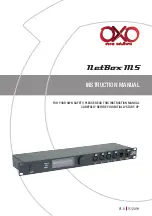
17
5. A cable run may be too long. Cable length for parallel communica-
tion must not exceed 20 feet (6.1 m) between any pair of devices; serial
cable length must not exceed 50 feet (15.2 m) for UTP or 500 feet (152.4 m)
for extended distance data cable. If either of your devices is too far from
the S
↔
P Converter it’s directly attached to, move the Converter or move
the device. If your Converters are too far from each other, move one of
them and, if necessary, its attached device.
6. If the problem isn’t solved, run the self-test on the output-side
Converter by setting its DIP switch position 6 to ON. If the self-test data is
not transmitted properly to the output device, you can concentrate on the
ouput device and cable as you search for the cause of the problem—turn
the self-test off and go to Step 8. If the data is transmitted properly, go to
Step 7.
7. Reverse the settings of position 6 on the two Converters, so that the
one on the output side is back to normal operation and the one on the
input side runs the self test. If the input-side self-test data is transmitted
properly, you can concentrate on the input device, its software, and the
input cable as you search for the cause of the problem. If the data is not
transmitted properly, you can concentrate on the cable and any adapters
between the Converters. Turn the self-test off and go to Step 8.
8. A cable might have come loose. If all cables are firmly seated, go to
Step 9.
9. A cable might be broken. Visually inspect the length of your cables
or continuity-test them. You can also try replacing the cable with identical
cable you know is OK.
10. If the problem isn’t solved, a cable or an adapter may be pinned
incorrectly. Any parallel cable connecting the parallel ports of your
Converter and a PC (RS-232 extension cable), as well as any UTP or EDDC
serial cable, should be pinned straight-through. This means that a single
wire connects Pin 1 at one end to Pin 1 at the other end. Likewise Pin 2 is
wired to Pin 2, 3 to 3, and so on. Also, the RS-232 extension cable must not
have Pin 1 tied to the shield.
If you’re using a pair of adapters with EDDC, compare the FA081-R2
adapter pinning listed in Figure 3-1 and in the Appendix with the pinning
listed in your adapter’s documentation (do
not
disassemble the adapter). If
you’re unable to determine the pinning of your adapter, or if you’re using
an adapter with a different type of connector, call us.
CHAPTER 5: Troubleshooting
Summary of Contents for PI035A
Page 26: ...NOTES...






































